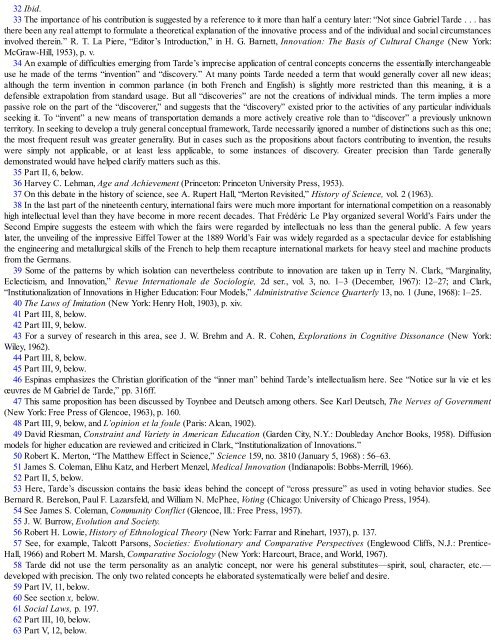3658925934
You also want an ePaper? Increase the reach of your titles
YUMPU automatically turns print PDFs into web optimized ePapers that Google loves.
32 Ibid.<br />
33 The importance of his contribution is suggested by a reference to it more than half a century later: “Not since Gabriel Tarde . . . has<br />
there been any real attempt to formulate a theoretical explanation of the innovative process and of the individual and social circumstances<br />
involved therein.” R. T. La Piere, “Editor’s Introduction,” in H. G. Barnett, Innovation: The Basis of Cultural Change (New York:<br />
McGraw-Hill, 1953), p. v.<br />
34 An example of difficulties emerging from Tarde’s imprecise application of central concepts concerns the essentially interchangeable<br />
use he made of the terms “invention” and “discovery.” At many points Tarde needed a term that would generally cover all new ideas;<br />
although the term invention in common parlance (in both French and English) is slightly more restricted than this meaning, it is a<br />
defensible extrapolation from standard usage. But all “discoveries” are not the creations of individual minds. The term implies a more<br />
passive role on the part of the “discoverer,” and suggests that the “discovery” existed prior to the activities of any particular individuals<br />
seeking it. To “invent” a new means of transportation demands a more actively creative role than to “discover” a previously unknown<br />
territory. In seeking to develop a truly general conceptual framework, Tarde necessarily ignored a number of distinctions such as this one;<br />
the most frequent result was greater generality. But in cases such as the propositions about factors contributing to invention, the results<br />
were simply not applicable, or at least less applicable, to some instances of discovery. Greater precision than Tarde generally<br />
demonstrated would have helped clarify matters such as this.<br />
35 Part II, 6, below.<br />
36 Harvey C. Lehman, Age and Achievement (Princeton: Princeton University Press, 1953).<br />
37 On this debate in the history of science, see A. Rupert Hall, “Merton Revisited,” History of Science, vol. 2 (1963).<br />
38 In the last part of the nineteenth century, international fairs were much more important for international competition on a reasonably<br />
high intellectual level than they have become in more recent decades. That Frédéric Le Play organized several World’s Fairs under the<br />
Second Empire suggests the esteem with which the fairs were regarded by intellectuals no less than the general public. A few years<br />
later, the unveiling of the impressive Eiffel Tower at the 1889 World’s Fair was widely regarded as a spectacular device for establishing<br />
the engineering and metallurgical skills of the French to help them recapture international markets for heavy steel and machine products<br />
from the Germans.<br />
39 Some of the patterns by which isolation can nevertheless contribute to innovation are taken up in Terry N. Clark, “Marginality,<br />
Eclecticism, and Innovation,” Revue Internationale de Sociologie, 2d ser., vol. 3, no. 1–3 (December, 1967): 12–27; and Clark,<br />
“Institutionalization of Innovations in Higher Education: Four Models,” Administrative Science Quarterly 13, no. 1 (June, 1968): 1–25.<br />
40 The Laws of Imitation (New York: Henry Holt, 1903), p. xiv.<br />
41 Part III, 8, below.<br />
42 Part III, 9, below.<br />
43 For a survey of research in this area, see J. W. Brehm and A. R. Cohen, Explorations in Cognitive Dissonance (New York:<br />
Wiley, 1962).<br />
44 Part III, 8, below.<br />
45 Part III, 9, below.<br />
46 Espinas emphasizes the Christian glorification of the “inner man” behind Tarde’s intellectualism here. See “Notice sur la vie et les<br />
œuvres de M Gabriel de Tarde,” pp. 316ff.<br />
47 This same proposition has been discussed by Toynbee and Deutsch among others. See Karl Deutsch, The Nerves of Government<br />
(New York: Free Press of Glencoe, 1963), p. 160.<br />
48 Part III, 9, below, and L’opinion et la foule (Paris: Alcan, 1902).<br />
49 David Riesman, Constraint and Variety in American Education (Garden City, N.Y.: Doubleday Anchor Books, 1958). Diffusion<br />
models for higher education are reviewed and criticized in Clark, “Institutionalization of Innovations.”<br />
50 Robert K. Merton, “The Matthew Effect in Science,” Science 159, no. 3810 (January 5, 1968) : 56–63.<br />
51 James S. Coleman, Elihu Katz, and Herbert Menzel, Medical Innovation (Indianapolis: Bobbs-Merrill, 1966).<br />
52 Part II, 5, below.<br />
53 Here, Tarde’s discussion contains the basic ideas behind the concept of “cross pressure” as used in voting behavior studies. See<br />
Bernard R. Berelson, Paul F. Lazarsfeld, and William N. McPhee, Voting (Chicago: University of Chicago Press, 1954).<br />
54 See James S. Coleman, Community Conflict (Glencoe, Ill.: Free Press, 1957).<br />
55 J. W. Burrow, Evolution and Society.<br />
56 Robert H. Lowie, History of Ethnological Theory (New York: Farrar and Rinehart, 1937), p. 137.<br />
57 See, for example, Talcott Parsons, Societies: Evolutionary and Comparative Perspectives (Englewood Cliffs, N.J.: Prentice-<br />
Hall, 1966) and Robert M. Marsh, Comparative Sociology (New York: Harcourt, Brace, and World, 1967).<br />
58 Tarde did not use the term personality as an analytic concept, nor were his general substitutes—spirit, soul, character, etc.—<br />
developed with precision. The only two related concepts he elaborated systematically were belief and desire.<br />
59 Part IV, 11, below.<br />
60 See section x, below.<br />
61 Social Laws, p. 197.<br />
62 Part III, 10, below.<br />
63 Part V, 12, below.









![Genki - An Integrated Course in Elementary Japanese II [Second Edition] (2011), WITH PDF BOOKMARKS!](https://img.yumpu.com/58322134/1/180x260/genki-an-integrated-course-in-elementary-japanese-ii-second-edition-2011-with-pdf-bookmarks.jpg?quality=85)
![Genki - An Integrated Course in Elementary Japanese I [Second Edition] (2011), WITH PDF BOOKMARKS!](https://img.yumpu.com/58322120/1/182x260/genki-an-integrated-course-in-elementary-japanese-i-second-edition-2011-with-pdf-bookmarks.jpg?quality=85)





